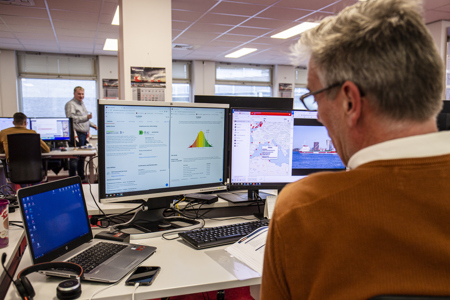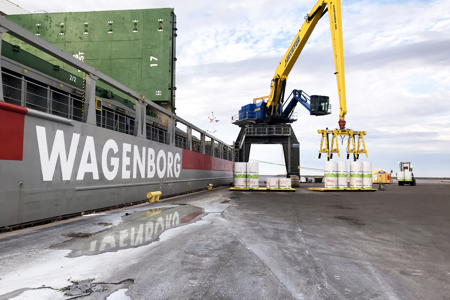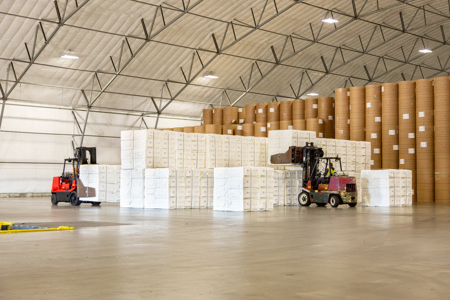
Successful North West Passage by Wagenborg
Egbert Vuursteen, CEO of Royal Wagenborg commented: “We are aware that the Arctic is an environmentally sensitive area and we therefore feel responsible for its natural features and its inhabitants. That’s why the Africaborg used low-sulphur gas oil, more than meeting the current requirements for the Arctic. That – as well as the relatively slow speed and the shorter route – served to minimise our impact on the environment and prevent damage to it.”
Built to meet the Finnish/Swedish ice class 1A (IACS Polar Class 7), the Africaborg is suitable for summer and autumn operations in first-year ice. This ice class designation makes her suitable for worldwide operations, including in ice-covered waters such as the St Lawrence Seaway, the Baltic, and the Canadian Arctic.
For her journey through the Northwest Passage, she was equipped with state-of-the-art preventive measures to detect any unforeseen deviations in the route. These included extra ice searchlights, an additional echosounder, and Iridium satellite communication. A second gyro compass was installed to back up the first because at that high latitude the regular magnetic compass could not act as the backup. The Africaborg also received daily ice charts, including satellite images, to guarantee a safe and efficient transit. Throughout the journey, she was supported by a shore-based team made up of Wagenborg’s technical and nautical specialists. An experienced Canadian Ice Navigator was also on board to advise the captain and the bridge during the journey.
As one of the Netherlands’ largest shipping companies, Wagenborg has always been a pioneer. Successfully conquering the Northwest Passage means that it is still a leader in terms of development. CEO Egbert Vuursteen sums up: “This remarkable journey marks a new milestone for Wagenborg, one that we couldn’t have achieved without the extraordinary preparation and support of the company’s shore-based team and Captain Erik Rosner and his crew for their safe and efficient navigation.”

Northwest Passage journey report
Erik Rosner, Captain of MV Africaborg
Erik Rosner has been a captain with Wagenborg for more than 17 years and has sailed throughout almost the entire world. As skipper of the MV Africaborg, he pioneered a new route for Wagenborg: the Northwest Passage. He went aboard on 20 August 2016 and a month later completed this memorable first voyage for Wagenborg. Here is his logbook.
25 AUGUST 2016
POSITION: 35°31’32.1”N 129°22’41.5”E – PORT OF ULSAN, SOUTH KOREA
"I came on board the MV Africaborg five days ago in Lianyungang (China) with the Vietnamese second mate V.P. Vu, and the Philippine seaman M.B. Garillo. At Lianyungang the Africaborg was loaded and we also took on board the additional equipment needed for the Northwest Passage. Unfortunately, the port authorities did not permit us to install the equipment there. Head office therefore planned a stopover at the port of Ulsan, South Korea. We arrived there today."
31 AUGUST 2016
POSITION: 41°37’33.1”N 141°30’39.2”E – SEA OF JAPAN
"We spent a few days in Ulsan, where the ice searchlights, the second gyro, and the echosounder were installed and extensively tested. Since our stopover in Korea, we’ve also been keeping a close eye on typhoon “Lion Rock” because it crosses our route. We therefore sailed at reduced speed for a number of days to the west of Japan so as to be relatively sheltered and to avoid the most extreme conditions. But we still had to deal with a force 8 gale, poor visibility, and heavy tropical rain. We’re now making 12 knots again so as to pass through the Tsugaru Strait between Hokkaido and Honshu during daylight hours on the way to Nome in Alaska."


9 SEPTEMBER 2016
POSITION: 64°29’38.8”N 165°26’22.7”W – NOME, ALASKA, USA
"After leaving Japan behind us, we have had a few days of fine, calm weather. That has allowed us to make good headway across the Pacific and the Bering Sea to reach Nome on schedule. We’ve now passed through three time zones. Yesterday, 12 miles off St Lawrence Island, we passed a Chinese research ship that was heading south from up north, the first ship we’ve sighted since 1 September. The ice navigator has just come on board and we’re starting the detailed planning for our transit."
11 SEPTEMBER 2016
POSITION: 71°20’24.2”N 157°26’44.6”W – CHUKCHI SEA
"At about 06 hours, we entered the Chukchi Sea. According to the ice charts, we should have encountered ice at about 11 hours. However, the expected ice ridge was in a different location. After passing it, we got a phone call from the US Coast Guard telling us that we would encounter multi-year ice further on. There was still about half a mile of open water off the coast of Point Barrow. We corrected our speed and course and then sailed in that direction. We followed the coast at reduced speed and continued on our way. We soon came across patches of multi-year ice of a beautiful blue colour. At a speed of about one knot, we navigated gingerly along and through the ice. At times we could make six knots for a little while, but most of the time we were almost at a standstill. It was difficult to find our way in the dark. It took us 18 hours to get beyond this patch. Getting through this part of the journey involved real teamwork: the ice navigator and I looked for passages through the ice and we used the engine to adjust our speed and to make tight turns with the propeller or to stop the ship when needed. One seaman steered and an officer of the watch continuously checked our position on the charts. The searchlights were essential at night so as to find our way through the ice."


14 SEPTEMBER 2016
POSITION: 71°20’36.1”N 136°09’32.6”W – BEAUFORT SEA
"After the ice area, we were expecting temperatures in the Beaufort Sea to be about minus 2 degrees Celsius and to produce freezing spray. But although the water came over the hatches, it didn’t freeze. We kept checking that every 30 minutes, but we were able to maintain our speed. Yesterday we entered Canadian waters, the “pingo” area. Pingos are icebergs that are largely underwater. Carefully working out a route is essential, and we checked that thoroughly. We also found that, given the updated ice charts that we received daily, it was only possible to get through the Northwest Passage via the narrow Bellot Strait, where there’s a strong current."
17 SEPTEMBER 2016
POSITION: 72°00’13.3”N 94°23’08.5”W – VICTORIA STRAIT and BELLOT STRAIT
"The actual Northwest Passage began the day before yesterday, when we entered the Amundsen Gulf. We neared the Canadian shore and passed through a shallow area off Cape Arnhem. We had to reduce speed there because of the shallowness of the water. After Outcast Island we could get back up to normal cruising speed towards the Edinburgh Channel, which we passed through yesterday. Today we passed through the Victoria Strait and the Franklin Strait without any difficulty, on our way towards the entrance to the Bellot Strait. We entered at 15.15 hours, with high snow-covered mountains and glaciers on either side. We were able to sail through at normal speed fairly easily. Only the final bit involved a difficult and narrow section with underwater rocks on both sides. By sailing parallel to the coast and continuously monitoring our position by GPS, we were able to leave the Bellot Strait at 17.45 hours. At the end of the channel there’s a refuge hut. The ice navigator told us that it provided food and shelter in an emergency. It’s more than 120 years old and it seems that old letters are still preserved there that you can read."


19 SEPTEMBER 2016
POSITION: 73°46’44.7”N 76°03’04.4”W – LANCASTER SOUND and BAFFIN BAY
"After the Bellot Strait we were able to pass through the Prince Regent Inlet without difficulty towards Lancaster Sound. Now and again we came across ice fields, so we had to sail at varying speeds. At Lancaster Sound we encountered considerably more ice than expected and we had to go 20 miles north to circumnavigate it. It ultimately took us 16 hours to find our way through. We even had to come to a stop and turn around occasionally so as to find a passage between the floating and underwater ice. Today we reached the most northerly point of our voyage. We finally came into open water and could sail into Baffin Bay. That meant we had officially completed the first Wagenborg journey through the Northwest Passage."
24 SEPTEMBER 2016
POSITION: 61°05’07.8”N 62°39’45.1”W – ATLANTIC OCEAN
From Baffin Bay we had relatively plain sailing southward at normal speed. In the Davis Strait and the Labrador Sea, we still passed large numbers of icebergs. At the moment, we are in the North Atlantic in dense fog. From here it’s another 3 days sailing to Baie Comeau, where we will cast anchor at our destination.




